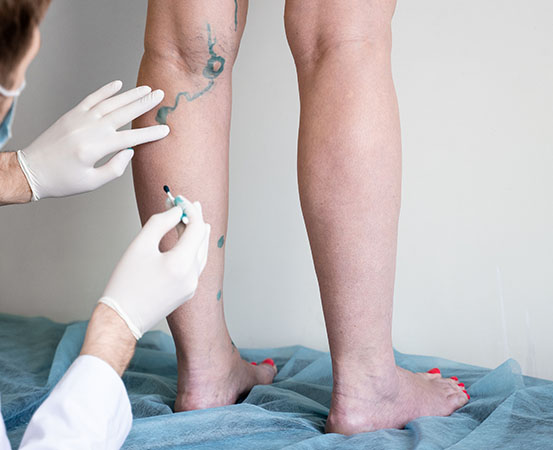
Leg pain had been bothering Bengaluru-based Hemalatha Chodisetty, 63, for over seven years, but only recently did she learn that she suffered from varicose veins, a condition where the blood veins in the calf muscles of both legs swell up and turn blue. After she underwent laser surgery in 2022, she has resumed her daily chores effortlessly.
What was most painful for Chodisetty was standing for long hours in the kitchen apart from during her ward visits. “As a corporator, I was actively involved in urban governance. Moving around [and] standing for long must have worsened my varicose veins,” she said.
Also called varicosities and varicoses, varicose veins are twisted and enlarged veins that run through the leg or feet, usually containing excess blood. Varicose veins are visible, straight, twisted or knotted.
In some cases, blood may leak leading to venous ulcers (ulcers in the veins), says Dr Shoaib Padaria, consultant interventional cardiologist, phlebologist and director of vascular science at Jaslok Hospital and Research Centre, Mumbai.
Varicose veins: Who is vulnerable?
Obese people, weightlifters, pregnant women and elderly persons are vulnerable to varicosities due to high abdominal pressure [caused by swelling and heaviness of the abdomen or uterus in case of pregnant women], explains Dr Madhu Prashanth D, interventional radiologist at Sakra World Hospital, Bengaluru.
According to the Office on Women’s Health, US Department of Health and Human Services, women are more likely to have varicose veins.
The traffic police, teachers, farmers and priests are also in the high-risk category as their occupation demands squatting or standing for long hours. Wearing high heels and having a family history of varicosities also add to the risk factors, says Dr Padaria.
“If both parents suffer from varicoses, it increases the chances by 50% and [by] 25% if one parent suffers from it,” he says.
Dr Prashanth adds that muscle inactivity in those with a hyper-sedentary lifestyle can also induce pressure, causing varicosities.
What causes varicose veins?
Veins are made up of valves that play a pivotal role in the onward and backward flow of blood between the heart and the ankles, explains Dr Padaria.
“Constant standing or sitting or high abdominal pressure can enlarge or dilate the veins. This dilation prevents the backward flow of blood from ankles to heart and leads to blood accumulation in the enlarged valves. The resulting pressure leads to varicose veins,” he adds.
If left untreated, varicosities can lead to venous ulcers in the ankles, says Dr Prashanth.
Dr Padaria agrees. “Too much blood pressure in the enlarged veins can cause blood and protein leakage into the superficial veins [veins close to the skin’s surface]. This leaves the skin warm, inflamed, dark and sometimes, itchy. While the condition resembles an eczema in people with varicose veins, it is a venous ulcer.”
Treatment for Varicose veins:
Dr Padaria emphasises that not every varicoses requires treatment. Many who develop visible veins (blue, brown or black coloured veins) don’t experience any pain. Also, not every pregnant woman develops varicoses, confirm experts.
“Interventional treatment is highly recommended when the veins are 6 mm and above in diameter. This prevents blood clots,” says Dr Padaria. To this, Dr Prashanth adds that for veins that are 3 mm in diameter, medical intervention is necessary when there is:
- Heaviness, swelling and pain in leg
- Painful muscle cramps in the thighs or feet
- Immense fatigue.

Varicose veins can be corrected through timely interventions, say experts. The first line of treatment for early varicose (Class 1 and 2) includes prescribed medicines and compression stockings to improve blood circulation in the veins to reduce pain or swelling. Resting the legs in a higher position and regular foot massages also help, says Dr Prashanth.
For severe cases, Dr Padaria points out that treatment aims at closing the leaking veins. It can be done in the following ways depending on the case.
- Laser treatment is the most effective long-term procedure for larger varicose veins (more than 3 mm in diameter). Here, a small wire with localised heat energy is inserted after local anesthesia to weld the vein and close it permanently. This requires no cuts or stitches. Chodisetty was recommended laser therapy and her varicoses were corrected successfully.
- Foam sclerotherapy is apt for smaller veins, says Dr Padaria. A chemical solution is injected into the tiny veins which closes the inner wall of the veins.
- Glue therapy is recommended only for the obese because local anesthesia may not penetrate the superficial or deep skin for laser treatment. So, glue is injected into the affected vein. This hardens like cement as soon as it is injected and helps block the vein.
Earlier, the surgical removal of veins (ligation and stripping) was practiced, but now it is considered risky as it can cause blood clots or even morbidity in rare cases.
Takeaways
- Varicose vein is a progressive condition. It can be corrected through timely interventions such as laser or foam sclerotherapy.
- To prevent varicose veins, avoid standing or sitting continuously for long hours. A hyper-sedentary lifestyle, gaining unhealthy body weight, lifting heavy weights in the gym and wearing high heels can increase the risk of varicosities.

















